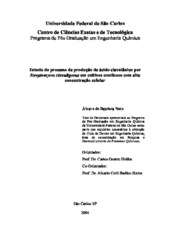Estudo do processo de produção de ácido clavulânico por Streptomyces clavuligerus em cultivos contínuos com alta concentração celular.
Abstract
The use of β-lactamase inhibitor in conjunction with β-lactam antibiotics was proposed to improve the efficiency of these antibiotics. The clavulanic acid is an important inhibitor of β-lactamase due its ability to inhibit several classes of β-lactamases. The clavulanic acid is a product from the secondary metabolism of
Streptomyces clavuligerus and its production rate is higher after the fast growing phase.
Higher productivities can be achieved in cultivations with high cell density. Therefore,
the objective of this work was to study the continuous clavulanic acid production process with high cell density, possible with the recycle of cells. Initially, experiments to determine the proper pH and medium compositions to improve clavulanic acid production by Streptomyces clavuligerus were performed.
Experiments to examine the effect of inhibition and/or repression by glycerol were also
carried out. Continuous culture without cell recycling was performed to develop a kinetic
model, including parameter determination, to simulate the process of clavulanic acid
production by Streptomyces clavuligerus. Classic models failed to describe the process and a kinetic model which takes into account the simultaneous consumption of glycerol and nitrogen source, as energy sources, was proposed.
To obtain high cell density, continuous cultivation with cell recycling was carried out. Among the methods examine to concentrate the cell mass, microfiltration was chosen because it is easily operated and allows the obtention of a limpid broth, as it is able to separate the totality of the cells from cultivation broth. This process eliminates the separation of cells in downstream processes. Concerning the problems such as oxygen transfer limitation and increase in the viscosity of culture broth, it has been observed that it does not hinder the applicability of continuous culture with cell recycling. The present work shows that continuous culture with cell recycling maximizes
the productivity, suggesting its utilization for clavulanic acid production by Streptomyces clavuligerus.
